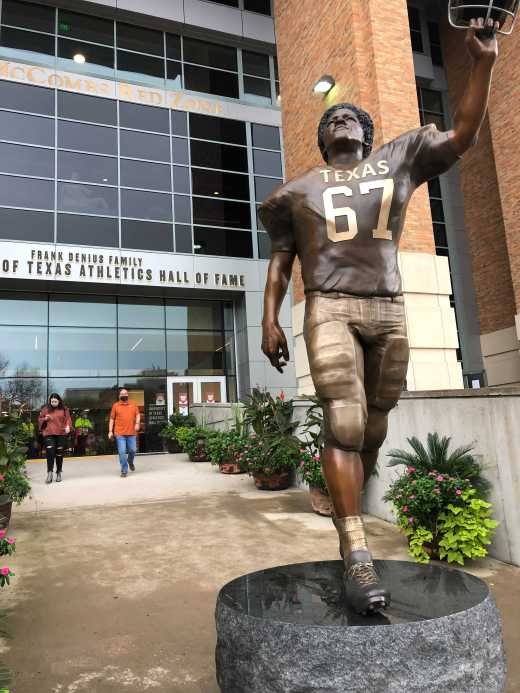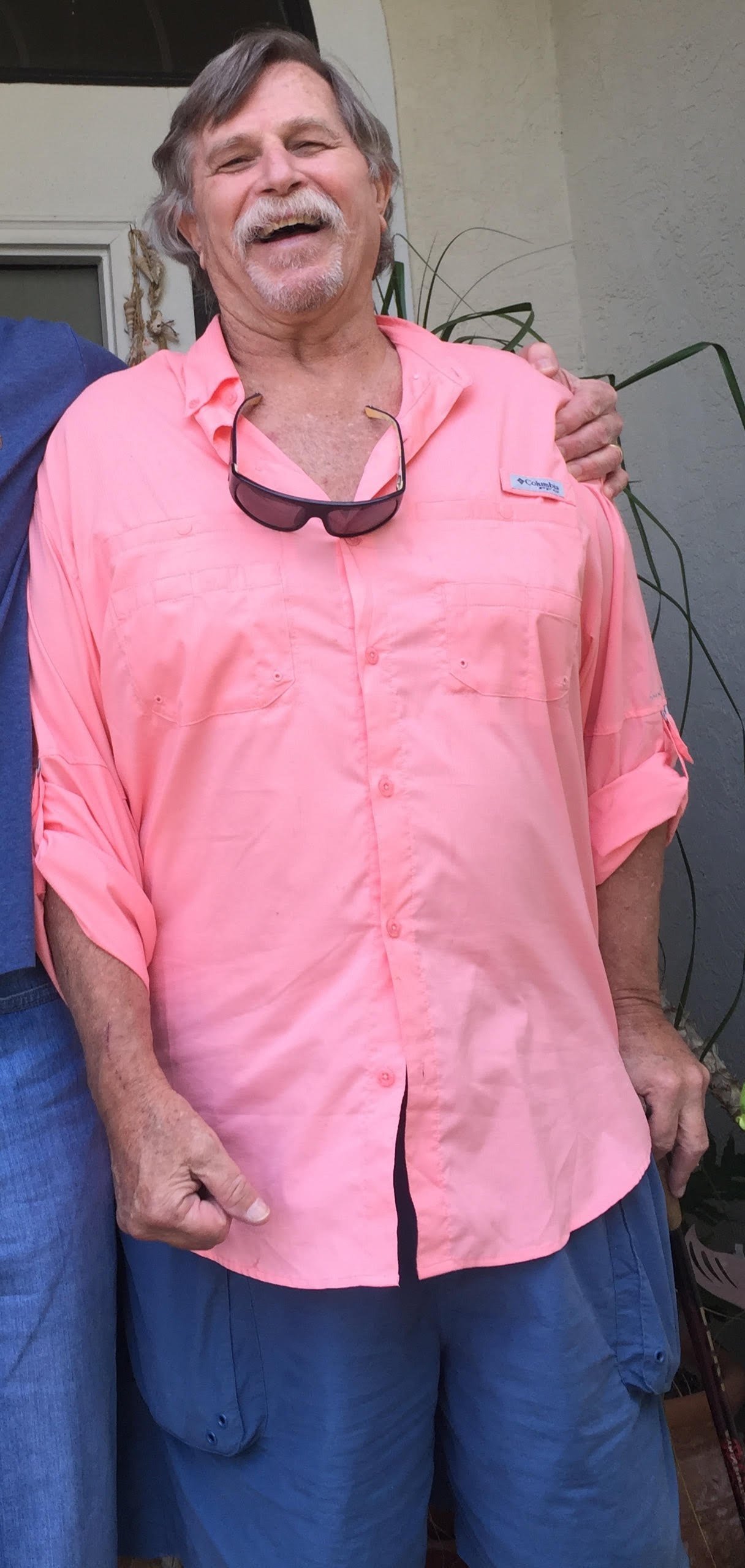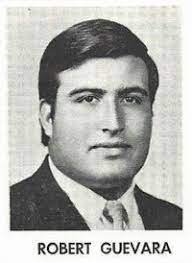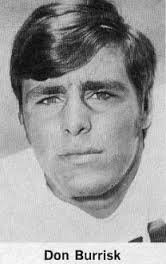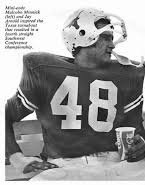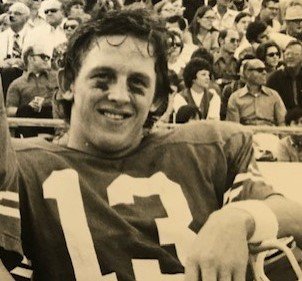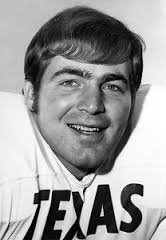Don’t mess with my Longhorns
FIFTY YEAR FOOTBALL FLASHBACK:
Won't Get Fooled Again
by Larry Carlson ( lc13@txstate.edu )
In March of 1971, University of Texas football coach Darrell Royal approached spring drills knowing that an abundance of teaching and coaching was ahead. The famed "Worster bunch," the greatest class of players in UT history was, well, history. All-Americans Steve Worster, Bobby Wuensch, and Bill Atessis had completed their eligibility, as had All-Southwest Conference performers Cotton Speyrer, Bobby Mitchell, and Scott Henderson, along with a dozen more notable players, all key contributors to a 30-game winning streak, three conference titles, and two national championships.
Royal surveyed the practice field and told writers, "There are a lot of empty saddles." But there were still plenty of hosses, studs, and wild bull-riders in the well-stocked corral. Superlative HB Jim Bertelsen was back for his senior campaign, as was QB Eddie Phillips, described by Royal as the best running quarterback the Horns had produced. Phillips had set a Cotton Bowl record just a few months earlier, ringing up 363 yards of total offense in a loss to Notre Dame.
From this 1971 football team, 17 athletes have passed away- most while in their 60’s. 10 of those died due to brain-related symptoms- Dementia, Alzheimer's, Parkinson's, depression/suicide, brain cancer, and CTE .
Link below is a Self portrait of CTE painted by Greg Ploetz.
Greg Ploetz
The defensive side for Coach "Iron" Mike Campbell returned young playmakers in LB Randy Braband, DB Alan Lowry and boasted a tandem of talented tackles, Greg Ploetz and Ray Dowdy. Ploetz, along with Phillips, Donnie Wigginton, Stan Mauldin, and Bobby Callison, were the last remaining players from the Worster bunch. An art major, Ploetz had sat out the '70 season, tussling with academic concerns and crucial classes that conflicted with Longhorn practices. Come '71, he had been re-recruited by the staff and elected to return for more football in his portfolio. the last remaining star from the Worster bunch represented the last link to the Worster bunch. class of 1967. Greg, An art major, had been tussling with academic concerns and crucial classes that conflicted with Longhorn practices. Come '71, he had been re-recruited by the staff and elected to return for more football in his portfolio.
Sophomores-to-be that spring (freshmen would still not be eligible for another year) had completed a highly successful freshman season the previous fall but were adjusting to their first spring drills with the big boys. Among the players expected to see substantial action would be a herd of players with experience on both sides of the football from high school days, including Glen Gaspard, Rick Vacura, Malcolm Minnick, Jay Arnold, Tommy Landry, and Greg Dahlberg. Swift halfback Don Burrisk had averaged almost eleven yards per carry in freshman ball, and Royal described him as "having a motor in his seat."
Larry, your story about the 1971 Longhorn team was on target. That season was my junior year and third of four as a manager. You captured the up and down and up roller coaster that was 1971, with the great start, the two losses in the middle, and the trip back up. Let’s leave the trip down at the Cotton Bowl for now!
Among the players who have died, do you count Steve Valek, the Bishop Lynch grad (and teammate of Jim McIngvale)? Steve was the off and on place kicker who for a short time held the Cotton Bowl record for longest field goal. Steve died at age fifty on April 6, 2001 in Lake Jackson. His widow Mimi recently retired as the president of Brazosport College.
David Anderson
Nobody could foresee the torrent of injuries that rained down that spring on the Horns. Arnold, now retired near Canyon Lake after practicing law for many years in his hometown of Liberty, recalled this month that perhaps ten-plus players, himself included, sustained spring football injuries that required surgery. He cited the "excellent program" of Charlie "Doc" Craven for getting almost all of the wounded ready for August two-a-days. Craven was essentially the Horns' first strength coach, according to the Stark Center for Physical Culture in Sports at UT. But one player, the standout LB/FB Vacura, a Minnesota product, had sustained such a debilitating knee injury that his gridiron days were, tragically, over before they had begun.
The injury bug of the spring, as it turned out, would become a veritable plague of locusts that would ravage the roster come autumn. Never before or since 1971 have so many key performers been felled or substantially slowed by injuries.
Texas began the season with a road game -- the back half of a home-and-home series -- in the City of Angels, to face the UCLA Bruins. A year earlier, the boys in powder blue had come within 12 seconds of upsetting the Horns in Austin, before a miraculous Phillips-to-Speyrer TD pass extended UT's winning streak to 23.
Arnold recalls the '71 Los Angeles trip as a learning experience in more ways than one. Some of the players got their first air travel. And the Longhorns, who seldom journeyed to locales more exotic than Dallas, Lubbock, and Waco, were then treated to a fancy haute cuisine meal on Friday night at the posh Century Plaza Hotel. When players eyed multiple forks and spoons at each of their place settings, Royal had new coaching to do. He kept it simple and all was well, briefly before the soup arrived cold. Grousing and grumbling spread rapidly, and Arnold says it was Ray Dowdy who first piped up to complain. Royal explained to the troops that this was gazpacho, a Spanish soup traditionally served cold, to refresh.
"Mama never served us cold soup at home...I want mine heated up," Dowdy said. Most team members followed suit with Dowdy's request and then the fine dining experience was enjoyed.
The Texas offense was plenty hot the next day, rolling up close to 500 yards in cruising to a 28-10 victory. Phillips ran for 143 yards on 20 carries to pace the Steers. But he aggravated a nagging hamstring and turf toe. As things would play out, the Cotton Bowl MVP had gained more than half of what he would rush for in the entire '71 season. He played in only six games, not completing one full contest until the Baylor game in November. Problems for Phillips merely foreshadowed what soon hit many teammates. After blanking Texas Tech, 28-0, in the conference opener, Texas hosted a talented Oregon team featuring future All-Pro QB Dan Fouts and a receiver, Bobby Moore, who later answered to the name of Ahmad Rashad. They did not prove to be a problem for the Texas defense in a convincing 35-7 win.
All the athlete photos below are from the 1971 team and Gone too soon.
Injuries did the damage Fouts and Moore couldn't, though. Speedy Jimmy Moore, UT's threat at WR and as a return man, went out for the season with a knee injury. Bertelsen, Woodard and others had sore shoulders and Phillips' injuries worsened. Now he would miss the OU game.
Texas hadn't lost to the Sooners since '66 and had won 12 of the last 13 series matchups but Royal knew that this OU outfit, now in its second wishbone season, was different. "They can scald it around the corners," DKR told reporters the week of the game. Speed killed, indeed, on Saturday, with the Okies putting 48 points on the board and beating the Horns by three TDs in the worst whipping a Royal squad had suffered. Adding injuries to the insulting results, Wigginton, the 5-8 QB who had filled in admirably for Phillips, suffered rib damage and was so sore he had to be helped into his shoes after a post-game shower. Worse, linebacker and captain Stan Mauldin would require season-ending knee surgery as would another senior, deluxe pass rusher David Arledge. Burrisk had a separated shoulder. Gaspard, FB Bobby Callison and TE Rick Davis were among the wounded-but-still-walking zombie corps.
It got even worse in Little Rock the following week, during a driving rainstorm. Arnold vividly remembers that the downpour included ripe oranges and emptied whisky bottles aimed at the Horns. With Phillips out and Wigginton extremely limited, a vengeful Arkansas team -- having lost Shootouts I and II in '69 and '70, and losses in '67 and '68, as well -- crushed the battered Horns, 31-7.
Texas had lost back-to-back games for the first time since '67 and a 21-game SWC win streak was gone.
The Longhorns had to face the music, and perhaps it was the rock'em, sock'em "Won't Get Fooled Again," from the album "Who's Next" by the Who. The eight-minute opus blared from every dormitory in America that fall, and now the lyrics about a revolution, an overthrow of power, seemed fitting for the old Southwest Conference, dominated by Texas three straight years and most of the past decade. Who would be next to wear the crown? Who would be next to beat up on a Texas team reeling on the ropes?
Alan Lowry, a gifted athlete who had lettered in baseball and would merit All-SWC honors that autumn as a defensive back, then earn All-Conference plaudits the next season as UT's wishbone QB, all the while also punting, looked back fifty years when I spoke by phone with him this month. The man who coached more than a quarter-century in the NFL, winning a Super Bowl ring in San Francisco and conjuring "the Music City Miracle" for the Titans, was blunt when he assessed October of '71.
"The Arkansas game was a real eye-opener," Lowry said. "We played the whole game in that rain and the whole team took a pretty good beating,"
Jay Arnold, a QB/DB back in Liberty, had been working on special teams and as a back-up linebacker as a sophomore. He got notice on the Monday following the Arkansas game to don full pads for that afternoon's practice, something not normally done. By Wednesday, Arnold and fellow linebacking soph Malcolm Minnick had been christened as defensive ends. Neither had ever played the position.
Arnold says now that he deduced that the coaching staff was plugging holes, piecing a puzzle back together in mid-season, trying to avoid any more losses. Writers and sportscasters across the region had already penciled in Arkansas to move into the SWC throne room this fall. Having whipped Texas, the Razorbacks looked like a shoo-in to cruise the rest of the season. Nobody was gonna beat UA now. And if somebody did, the Porkers had already won the head-to-head battle with UT. Hog heaven would be Dallas on New Year's Day, and travel reservations were being made, from Fayetteville to Fort Smith to Forrest City.
But diminutive Donnie Wigginton's wishbone and the once-proud, now bowed Texas defense still had five games to make something positive from a 3-2 start. The road back to redemption began at home with a crisp 39-10 spanking of the Rice Owls. Wigginton ran for 120 yards and three touchdowns and Lowry took an interception back 52 yards for another score.
Then Texas returned to Dallas' Cotton Bowl to battle an SMU team that had won three of its last four. The Horns survived a stern test and beat the Mustangs, 22-18. Arnold said a defensive stand deep in Texas territory was key and saluted Randy Braband along with Ploetz and Dowdy as leaders in the season's second act surge. He flashed back to a burly SMU lineman, screaming that game officials had shorted the Ponies on a fourth-down measurement after the aforementioned trio had stuffed a run.
"Braband held the Horns up in his face and said, '(the ref) said you missed it by this much," Arnold laughs. "Then he trotted off the field."
At about the same time that day, a 2-5 A&M team upset eighth-ranked Arkansas in Little Rock. The Hogs' armor, and conference lead, had been dented.
One of the main reasons Texas was still alive in the conference standings was Ploetz. The art major was enjoying a masterful season. Ploetz, all 5-10, 205 pounds of him, was outplaying everybody in the conference, and would be honored in December as the SWC's Outstanding Defensive Player.
"You looked at Greg Ploetz and you'd say there's no way this guy could play tackle. He was undersized," Lowry says. "He loved playing and he made the most of every bit of his ability. Leverage, quickness, he used it all. Because of that, he became the player he was."
Ploetz would later graduate and excel as an artist and art teacher for four decades. And he at times had an artist's unique perspective on the gridiron. Jay Arnold was a self-described wide-eyed sophomore learning a new position, defensive end, in '71 but was fortunate enough to have Ploetz neighbor him at tackle. Arnold remembers basic jitters while a visiting team huddled during a timeout to explore new ways to possibly exploit any weakness in the Horns' defense. Let Arnold pick up the narrative:
"I was chomping at the bit. Greg was standing next to me, looking up into the stands. He quietly said, 'Can you believe this?' I'm thinking strictly football stuff, the next play....not screwing up...what formation they'll be in. He repeated himself. 'Can you believe this? I said, 'What?' Still gazing into the stands, he said, 'Can you believe this many people are sitting in this heat watching a (bleep)-ing football game?"
Arnold said he was tossed a curve by Ploetz's seemingly abstract, esoteric take. Then the huddle broke. "Don't let them get outside of you," Ploetz instructed the soph. "Because I'm going to be here all day."
Sure enough, the visitors ran off-tackle and Ploetz got low to make the stop.
"As we were getting off the pile, Greg said 'That's the way....keep 'em coming inside.'"
"He helped me a lot that year, and I learned a lot from him," Arnold says, fondly remembering his tough and talented teammate.
Ploetz, Dowdy, Braband, captain Tommy Woodard (now shifted from TE back to LB to fit the puzzle), Lowry and the sophs -- Gaspard, Arnold, Minnick and rover Bruce Cannon — were being forged into a formidable unit by coaches Mike Campbell, Fred Akers, R.M. Patterson, David McWilliams and Tim Doerr. On November 6 in Austin, Texas shut out Baylor, 24-0. Off to the east, only 32,000 fans -- most of them from Arkansas -- were rattling around in spacious Rice Stadium. An Owl team owning only two victories rose up and stunned the Razorbacks with a 24-24 deadlock.Ploetz, On November 6 in Austin, Texas shut out Baylor, 24-0. Off to the east, only 32,000 fans -- most of them from Arkansas -- were rattling around in spacious Rice Stadium. An Owl team owning only two victories rose up and stunned the Razorbacks with a 24-24 deadlock.
A mere three weeks earlier, the Arkansas Razorbacks had bludgeoned a staggering UT squad and looked forward to their first Cotton bowl in five years. Now a patchwork quilt of a team, filled with wounded, shifted-around players beginning to heal and find their way, was peaking at the proper time. The Steers had re-gained their swagger, and had climbed back atop the SWC standings. Cue some lyrics from The Who:
"And the world looks just the same,
And history ain't changed...."
Yep, the men in burnt orange were back in charge at the same old stand, meaner than ever. Lowry sums it up simply while looking back now. "We had great leadership and all the players that stepped in, stepped up and played really well."
That view is echoed by Arnold. "I think every man on that team worked to make it happen, in spite of the injury situation."
Phillips was even back in form for parts of the late-season surge but Wigginton was flourishing and piloting the wishbone the way Eddie and James Street had, although with a banged-up band of backs behind him. Bertelsen, as steady and dependable a back as has ever come through the Forty Acres, played while hurt and still piled up 90 yards per game while delivering textbook blocks for others. Bobby Callison, fighting through injuries, got most of the other carries, with Dennis Ladd also contributing.
The Texas offensive wall was anchored by All-American tackle Jerry Sisemore, perhaps the greatest Longhorn ever at his position. Veteran Travis Roach and precocious sophomores Don Crosslin and Bill Wyman were coming on strong.
But it was the pepper-pot, carrot-topped Wigginton who perhaps best personified the Longhorn team filled with guys answering the "next man up" call to duty. In fact, the senior whose previous highlight was pulling down a high snap for the hold on Happy Feller's winning PAT in the '69 Arkansas game, tied Steve Worster's UT record for rushing touchdowns in a season, with fourteen. And he hit more than fifty percent of his passes.
"Donnie was a fierce competitor," Jay Arnold testifies. "He stepped up when the situation demanded, and after the Arkansas game there were nothing but W's, so his record speaks for itself."
Armed with a one-half game lead in the mid-November standings, Texas overwhelmed TCU, 31-zip, in Austin, to finish its fourth straight year of undefeated play at home. Then the Horns hit the road to blast the Aggies, 34-14. It was UT's 14th win over the Farmers in the past 15 years, If it didn't all add up to global peace, at least normalcy had been restored. The loss to Arkansas was ancient history, and mattered little.
Texas would be teeing it up for a fourth straight Cotton Bowl game, another SWC championship trophy being engraved to ship to the Forty Acres. Arkansas and the conference's other pretenders to the throne had been premature in celebrating the Longhorns' demise.
"We didn't panic," Alan Lowry says from his home in Franklin, Tennessee, just south of Nashville. "I don't think the team ever thought we wouldn't make it to the Cotton Bowl."
Flashing back musically, the grand finale of "Won't Get Fooled Again," guitarist/songwriter Peter Townshend's cautionary tale of revolt and overthrow, seemed marvelously appropriate as the curtain fell on the 1971 SWC football season.
"Meet the new boss....same as the old boss."
Just insert closing musical notes, drop the mic and smash guitars on stage.
The Texas Longhorns had won the championship. Again. Four straight. The seven other conference teams could try again next year.
Spoiler alert: Texas would win a fifth straight title the following season. And a sixth in '73. Who's next as champions?
From 1968 through 1973, the answer was easy. Even if getting there, especially in '71, was not.
End of Professor Larry Carlson’s article about the 1971 Longhorn football team.
A note from Billy Dale concerning Professor Carlson’s article
ATHLETES WHO PLAY FOOTBALL USE THEIR HEADS AS A BATTERING RAM. The RESULT- FOOTBALL PLAYERS ARE PRONE TO MIS-DIAGNOSED CTE as Dementia or ALZHEIMER'S, DEPRESSION/SUICIDE, PARKINSON'S, and even maybe brain cancer.Greg Ploetz was on the 1971 team. The road that Greg and Deb Ploetz traveled from 2009 until his death from CTE reflects the struggles many Longhorns and their families experience with loved ones inflicted with brain-related "diseases". After Greg was diagnosed, he painted a tribute to his teammates. The completion of this painting in 2010 captures his heart holding on while his mental capabilities and hand-eye coordination suffered. He was struggling with details. The painting reflects that decline.The painting is historically incorrect, but it offers a glimpse into Greg's struggle to remember facts. Norman Rockwall decades ago rendered a piece of art titled "Self-portrait". Greg Ploetz has rendered a self-portrait of CTE.Even though Greg was a defensive player as a Longhorn, in this painting, Greg ( #31) believes he is the offensive player who delivers the key block that results in James Street's" (#16) 1970 winning touchdown run in the national championship game against Notre Dame. In fact, James Street does not make this touchdown, the Notre Dame jerseys are not blue, and the stadium architecture is not the Cotton Bowl.This painting reflects what CTE looks like from Greg's state of mind. However, for all of us who love him, we understand this painting is not about art. Paintings deliver messages that words can never yield (a picture is worth a 1000 words), and Greg's message is delivered. The painting champions the heart and the human spirit's temporary victory over an aggressive opponent. It is battle won in a war he will lose. A link to a Self Portrait of CTE as painted by artist and All SWC football player Greg Ploetz is belowhttps://texas-lsn.squarespace.com/a-self-portrait-of-cte
End of Bily Dale’s comments



